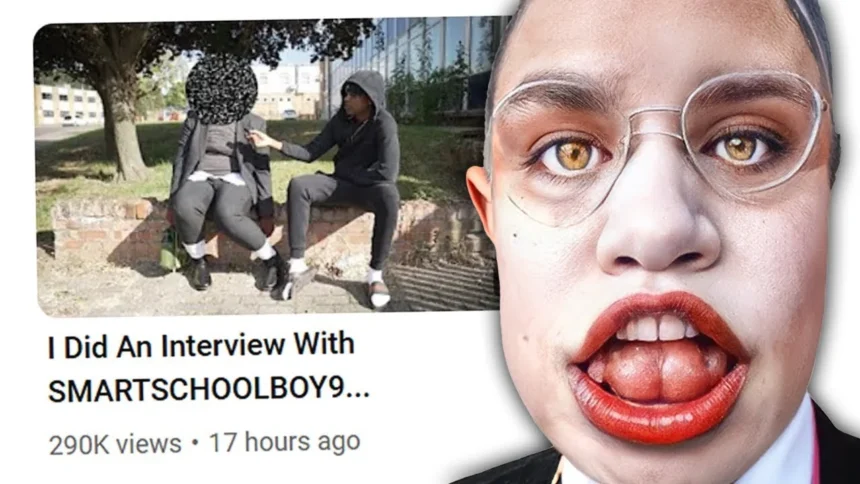SmartSchoolBoy9 is an online persona (or several related accounts/personas) operating on social media, most prominently on Instagram, which has raised serious safeguarding concerns.
Key features:
- The individual is believed to be male, but pretending to be a child. He may masquerade as a school-aged boy (or sometimes girl) in images, videos, and posts.
- Use of AI-generated or manipulated images alongside real images/videos. Some images are distorted or edited.
- The content often features school uniforms, with the uniform itself being a recurring theme. Some of the poses are considered suggestive, sexualised or blurring lines of what is appropriate
- The account(s) appear(ed) to interact with children online (e.g. commenting on children’s posts) in ways that raise concerns. Tasks like “befriending” via comments etc.
- It is uncertain exactly how many accounts are involved, whether some are removed, what aliases are used, and whether new ones are emerging.
So in summary: a possibly adult person using child personas and content that sexualises children, generating risk for children on social media.
History & Timeline of Events
Understanding how long this has been going on helps in assessing how serious and how well known the issue is.
| Approximate Date | What Happened / Discovery | Notes / Relevance |
|---|---|---|
| 2018 | Alleged start of content generation. The individual might have begun producing related content since this time. | If true, that’s many years of undetected or unreported activity. |
| 2024 (April onward) | The persona “SmartSchoolBoy9” started being more widely noticed. Reddit and other social-media “internet sleuths” began investigating. | Sparked broader attention and concern. |
| September 2024 | Safeguarding alerts released by groups such as INEQE Safeguarding Group and “Our Safer Schools”. | Formal attempts to warn parents, schools, carers. |
| Late 2024-2025 | Copycat accounts, misinformation spread, increasing social media discussions. Schools get involved (some pupils anxious, parents concerned). Authorities are being encouraged to monitor |
So: It is a growing concern over recent years, not just a one-off hoax.
What Are the Risks Involved?
SmartSchoolBoy9 isn’t just a weird internet mystery—it has real risks, especially for children, parents, schools, and online platforms.
-
Child Safety and Sexualisation
-
The account(s) use child imagery/uniforms in suggestive ways. Even if no direct grooming or abuse is proven yet, sexualised content involving minors is dangerous and can normalise harmful behaviour.
-
Exposure to this content can distress children, confuse them about appropriate boundaries, or push them towards unsafe online interactions.
-
-
Manipulative Interaction / Potential Grooming
-
Interactions with children (even via comments) can create trust, opening the possibility of more direct contact. If someone is pretending to be a peer, children may let down their guard.
-
Use of AI or manipulated content also complicates identification of truth: children may believe false representations.
-
-
Copycat Accounts and Escalation
-
Once the idea spreads, other people may imitate the behaviour, increasing the spread of harmful content.
-
Accounts can be re-created under different aliases, or content reposted, making removal difficult.
-
-
Misinformation, Panic, and Fear
-
False claims (for example about lockdowns, school incidents) are being spread in relation to SmartSchoolBoy9. This causes panic among kids and parents.
-
Attempts to doxx or identify the person publicly can backfire or complicate legitimate investigations.
-
-
Emotional and Psychological Impact
-
Younger children exposed to these images/videos may be frightened, anxious, or confused. Some have reportedly refused to attend school due to fear.
-
Long-term exposure to sexualised content or unsafe online interactions can impact mental health.
-
How Authorities, Schools & Platforms Are Responding
There have been several reactions already, with more likely to come as more information emerges.
Safeguarding Alerts:
Organisations like INEQE Safeguarding Group and Our Safer Schools have published alerts with details, asking schools, parents, carers, and safeguarding professionals to be vigilant.
Advice and Guidance for Parents & Carers:
Tips include monitoring children’s social media usage, having open conversations about what they see online, showing them how to block, mute or report concerning accounts, and reassuring children if they’re worried
Platform Oversight & Takedowns:
Some accounts reported have been taken down, or disabled, possibly as a result of community reports or platform policies. But because of aliases, AI imagery, and the ability to create new accounts, this is an ongoing challenge.
School Involvement:
Some schools have incorporated information about SmartSchoolBoy9 into their online safety education for pupils and parents. Also, school safeguarding leads are being asked to stay alert.
Media & Internet Investigations:
Social media users, Reddit threads, YouTube documentaries are investigating and raising awareness. While helpful in raising visibility, some of this may also generate misinformation.
What Should Parents, Guardians & Educators Do?
Knowing about the risk is one thing; acting to protect children is another. Below are concrete steps that can help reduce exposure to this kind of harmful content, and help children stay safe.
-
Have Open, Non-Judgmental Conversations
-
Don’t wait for a crisis. Ask children what they’re seeing online. If they mention something like SmartSchoolBoy9, let them explain in their own words.
-
Use questions like “What have you seen that worried you?” rather than “Did you see something bad?” to encourage honesty.
-
Make sure children know they can come to you without fear of punishment or shame.
-
-
Teach Critical Thinking About Content
-
Help children understand that not everything they see is real (images/videos can be manipulated or AI-made).
-
Discuss safe vs. unsafe behaviour online: what are appropriate boundaries, what to do if someone asks for private information, or tries to become “friends” with them in suspicious ways.
-
-
Use Parental Controls & Privacy Tools
-
Use privacy settings on social media to restrict who can follow/comment/messsage.
-
Teach children to block, mute, and report accounts.
-
Monitor usage in an age-appropriate way: know what apps they use, who they’re interacting with.
-
-
Limit Overexposure & Social Media Algorithms
-
Be aware that algorithms amplify content that gets more engagement—even if it’s alarming or sensational. So exposure to SmartSchoolBoy9-type content may spread easily, even unintentionally.
-
Encourage healthy offline activities and breaks from screens.
-
-
Coordinate with Schools & Safeguarding Leads
-
Schools can include SmartSchoolBoy9 in their online safety curricula.
-
Safeguarding leads should monitor if any child is being disturbed or frightened, and liaise with parents/caregivers.
-
Schools may provide counselling or psychological support if children are impacted.
-
-
Report Concerns & Avoid Vigilantism
-
If you encounter accounts you believe violate platform policies (sexual content, impersonation, etc.), report them.
-
Avoid trying to unmask or doxx the person yourself—it may be dangerous, inaccurate, or interfere with investigation.
-
Contact local authorities if you believe a real law is being broken.
-
Key Questions & Uncertainties
There are several things that aren’t clear yet, which makes this situation more complicated. Here are some of the open questions that experts, investigators, and the public are still trying to resolve:
- True Identity & Location: Who is behind SmartSchoolBoy9 exactly? Where are they based? What is their motive (art project, fetish, psychological issue, or deliberate predatory behaviour)? Some sources suggest a man named David Alter, possibly in England.
- Extent of Interaction with Children: Has there been direct one-to-one contact? Has grooming or abuse occurred? What children have been affected?
- Legal Status: Are there any ongoing investigations by law enforcement? Has any criminal charge been filed? Not publicly confirmed.
- Platform Action: How effectively are social media platforms detecting and removing all related accounts? How many are copycats vs originals?
- Psychological Impact: What lasting effects on children who see such content? How afraid are they, how much misinformation are they exposed to? Studies/timely surveys are needed.
Because some claims are based on user-reports, social media investigations, and media content, verification is sometimes difficult.
Broader Implications for Online Safety
SmartSchoolBoy9 is disturbing, but it’s not an isolated phenomenon. It tells us a lot about broader challenges of protecting children online in modern social media environments. These are lessons that go beyond this specific case.
- AI / Manipulated Content: As AI image generation/manipulation becomes more accessible, distinguishing real from fake becomes harder. People can use AI to create deceptive profiles, images, etc.
- Algorithm Amplification of Harmful Content: Social networks tend to promote content that gets engagement. Disturbing, sensational, or controversial content often gets high engagement (views, comments, shares), which risks amplifying harmful content.
- Blurring of Peer / Adult Personas: Someone pretending to be a child or using child personas can trick young users into trusting them. It becomes harder for children to distinguish.
- Information Spread / Misinformation: Rumours, false claims, panic can spread quickly. The “SmartSchoolBoy9” situation already has false stories (e.g. lockdowns, etc.). Having good information and trusted sources is key.
- Need for Better Tools, Policies, Education: Platforms must improve detection / content moderation. Schools, parents need to be more involved in digital literacy. Laws may need updating regarding AI content and impersonation.
Conclusion
SmartSchoolBoy9 represents a troubling case of how social media, anonymity, and emerging technologies (like AI-image generation) can combine into a potential risk for children and young people. While not everything is confirmed, many red flags are present: sexualised imagery, impersonation, possible interaction with children, multiple accounts, and spread via copycats and algorithmic amplification.
What we do know:
- It’s real, not just a creepypasta or a myth.
- It presents real risk.
- Awareness and response are growing among authorities, schools, parents.
What remains uncertain: identity, legal status, how many children are affected, and full scope of content spread.








